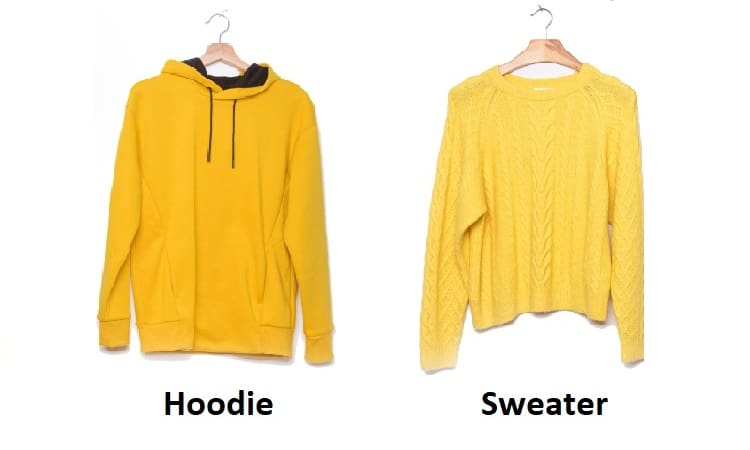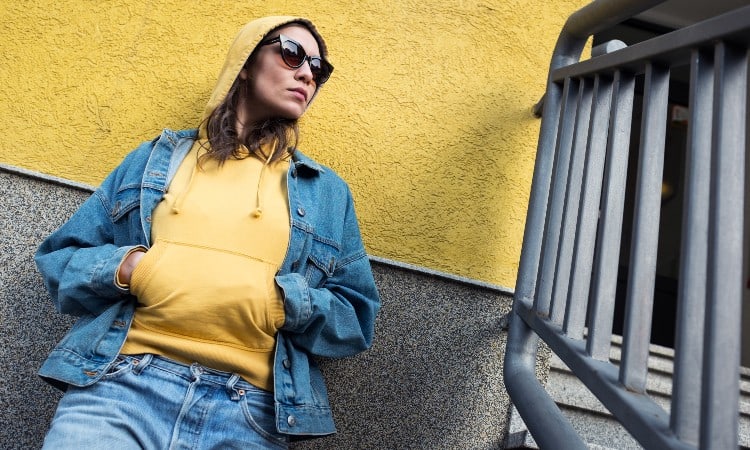As the weather cools down, it’s time to start reaching for mid-layers to keep you warm. There are tons of options to cozy up, like hoodies and sweaters. But what’s the difference between them all? Can you wear them to the same events? How do you style them?
A hoodie is a type of sweatshirt with a hood attached to the neckline. Hoodies usually have a large kangaroo pouch pocket on the front. Sweaters are a category of a cold-weather garment, usually made of wool and either crocheted, hand-knit, or machine knit.
On the surface, it might seem obvious what the differences are between these two garments. However, there are nuances of fabric, construction, and even cultural connotations that separate these items. This guide breaks down the great hoodie vs. sweater debate.

Hoodie vs. Sweater: Key Points
The most obvious difference between hoodies and sweaters is the hood. But if you take a closer look, there are more details that make these garments unique from each other. For starters, hoodies are a type of sweatshirt, whereas sweater is a broader garment category.
The chart below lays out these details in a quick reference format for you!
| Element | Hoodie | Sweater |
|---|---|---|
| Fabric Type | Fleece, French terry, cotton & cotton blends | Wool or wool blends |
| Garment Shape | Kangaroo pocket, usually no waist shaping or darts; sometimes zippers | Various; can include shaping or darts; usually a pullover |
| Hood? | Yes | No |
| Uses | Loungewear, athletic wear | Casual wear |
| Construction | Seamed | Seamed or seamless; |
While sweaters and hoodies are different garments, there is overlap in their original purpose and current use. They are divided more by style and fashion considerations than by functional differences. But what exactly makes a hoodie a hoodie? And why is that different from a sweater?
What Is a Hoodie?
 A hoodie is a specific type of sweatshirt. The defining characteristic is the hood. Without a hood, the garment is just a sweatshirt, not a hoodie. Hoodies also usually have a kangaroo pouch pocket on the front.
A hoodie is a specific type of sweatshirt. The defining characteristic is the hood. Without a hood, the garment is just a sweatshirt, not a hoodie. Hoodies also usually have a kangaroo pouch pocket on the front.
Hoodies are casual garments. They’re loungewear or athletic wear. People wear them as a warm-up before sporting events or as a way to stay warm in casual settings. They’re also not uncommon as part of the cold-weather uniform for manual laborers or other tradespeople who work outdoors.
There are multiple cultural links to hoodies. The garment is often associated with young people and it can have classist connotations. While the materials and construction of hoodies are very similar to other sweatshirts, the cultural connotations keep it out of more formal settings.
There are both pullover and zip-front hoodie styles. For zip-front hoodies, the kangaroo pocket is divided in half by the zipper. The hood in a hoodie generally has a drawstring threaded through the outside edge to cinch the hood close around the wearer’s face.
Hoodies are common garments for teams, organizations, or souvenirs. They’re usually made of cotton, French terry, or a cotton/polyester/elastane blend called sweatshirt fleece. The right side of the fabric is smooth, which makes it optimal for screen printing or embroidering logos. Meanwhile, the wrong side is fuzzy, which makes the garment comfortable and cozy.
There are some fashion variations on the hoodie, including short-sleeve and vest versions of a hoodie. The typical hoodie doesn’t have shaping or darts. However, specialty hoodies might have gentle waist-shaping, especially if marketed as women’s hoodies rather than unisex hoodies.
What Is a Sweater?
 Sweater is a much broader garment category. The term usually refers to warm wool or wool-blend tops with long sleeves. They’re made to be warm and layer easily over shirts and under jackets. There are many kinds of sweaters—but more on that later!
Sweater is a much broader garment category. The term usually refers to warm wool or wool-blend tops with long sleeves. They’re made to be warm and layer easily over shirts and under jackets. There are many kinds of sweaters—but more on that later!
Sweaters can be casual garments or more structured formal pieces. The shape, fit, and material of a sweater indicate whether it is a fancy wardrobe item or not. Themed sweaters are also common, such as the ugly Christmas sweater.
Sweaters vary in weight, thickness, and garment style as well. There are short-sleeve sweaters, sweaters with buttons, and sweaters with zippers. There are various neckline options, including turtleneck, cowl, crew, boat, and v-neck.
Some sweaters have waist-shaping and darts, particularly hand-made or custom-fit sweaters. While they aren’t a tight garment, their history and place in the slow fashion movement mean they are often tailored to the wearer’s body.
Traditionally, sweaters were hand-knit or crocheted garments. Today, there are machine-knit sweaters and sweaters that aren’t made of wool at all. Synthetic fibers that mimic wool qualities are readily available commercially.
Like hoodies, sweaters have their roots in cold-weather protection for laborers. However, the wide variety of garments in this category has grown to include more formal pieces. Since the rise of commercial and machine-made clothing, hand-made sweaters have taken on a more expensive, luxurious connotation.
What Are the Differences Between Hoodies and Sweaters?

The primary difference between hoodies and sweaters is the hood. A sweatshirt without a hood is not a hoodie. Hooded sweaters do exist, but they are rare.
Other than the hood, the fabric choice is a good indication of whether a garment is a hoodie or a sweater. Cotton and fleece fabrics are the top choices for hoodies, whereas wool and wool blends are typical sweater materials.
It’s also worth noting that a hoodie is part of the larger category of sweatshirts, while sweaters are a category of their own. For instance, a cardigan is a type of sweater, while a hoodie is a type of sweatshirt. This difference is why there are so many more kinds of sweaters than kinds of hoodies.
These garments also have different uses. Hoodies are a more casual garment than sweaters. Hoodies originated in the 1930s as a way to keep outdoor workers warm during the winter; they served a similar purpose to garments like coveralls or workmen’s jumpsuits.
Sweaters first arrived in the clothing industry in the 15th century. They were also originally made to keep laborers warm, though they were specifically for fishermen and sailors. Over time, sweaters and hoodies diverged, with hoodies having a closer association to loungewear and sweaters having a more all-purpose role in the wardrobe.
Are Hoodies the Same as Sweatshirts?
 Hoodies are a type of sweatshirt. The term sweatshirt refers to the group of garments made out of sweatshirt fleece or similar material. This fabric is a thick material with a smooth outside and fleece inside. Not only does this design feel nice against the skin, but it also helps trap body heat.
Hoodies are a type of sweatshirt. The term sweatshirt refers to the group of garments made out of sweatshirt fleece or similar material. This fabric is a thick material with a smooth outside and fleece inside. Not only does this design feel nice against the skin, but it also helps trap body heat.
Hoodies are a specific construction style of sweatshirt. There are other styles of sweatshirts that don’t count as hoodies, specifically because they don’t have a hood. At the same time, not all hooded jackets are sweatshirts.
Outerwear can have hoods, too. When a garment is both a sweatshirt and it has a hood, then it is a hoodie. Jackets, raincoats, and parkas are all examples of hooded garments that are not hoodies because they serve a different purpose and are made of different types of material.
Sweatshirts are also different from sweaters. Sometimes sweater is used as a catch-all term for a warm mid-layer, but sweatshirts are more specifically garments made out of sweatshirt fleece.
Are Crewnecks the Same as Hoodies?
 Crewnecks and hoodies are not the same. Crewnecks cannot be hoodies because crewneck refers to the type of neckline a sweatshirt has. The neckline on a hoodie is opening left by the hood.
Crewnecks and hoodies are not the same. Crewnecks cannot be hoodies because crewneck refers to the type of neckline a sweatshirt has. The neckline on a hoodie is opening left by the hood.
Because crewneck describes the shape of a neckline on a garment, you can have crewneck sweaters, crewneck sweatshirts, and crewneck t-shirts. A crewneck is a round, ribbed neckline that sits at or just above the points of the collarbone.
The term crewneck is sometimes used as shorthand for a crewneck-style sweatshirt. For other garments with that neckline, manufacturers and retailers usually describe the garment further, i.e., a crewneck t-shirt.
Retailers often have crewneck sweatshirts and hoodies that have similar or identical designs. Even if the two garments are made of the same material and have the same design, the neckline and pocket differences make one a crewneck and the other a hoodie.
Are Pullovers the Same as Sweaters?
 A pullover is a style of sweater. It can also refer to a style of sweatshirt. A pullover just means the garment doesn’t unzip or unbutton. To put it on, you have to pull it over your head. Unlike other tops, you have to pull on. However, pullovers are a warm layer, not a base layer.
A pullover is a style of sweater. It can also refer to a style of sweatshirt. A pullover just means the garment doesn’t unzip or unbutton. To put it on, you have to pull it over your head. Unlike other tops, you have to pull on. However, pullovers are a warm layer, not a base layer.
The term pullover is sometimes used as shorthand for sweaters or sweatshirts. Crewneck sweatshirts can be pullovers, as can v-neck sweaters. A pullover can have a variety of necklines, sleeve lengths, and garment shaping. The defining feature is that it doesn’t have any fastenings; it’s all one piece.
The same way that crewneck refers to a specific neckline construction, a pullover is just one element of a garment. Pullovers come in different shapes and construction styles. You can have yoked or raglan pullovers as well as drop-shoulder or even saddle-shoulder pullovers.
Are Cardigans the Same as Sweaters?
 Like pullovers, cardigans are a style of sweater. Cardigans do not pull over your head. They have two flaps in the front that close with some type of fasteners, such as buttons or snaps. There are also open-front cardigans where the flaps do not have a fastener.
Like pullovers, cardigans are a style of sweater. Cardigans do not pull over your head. They have two flaps in the front that close with some type of fasteners, such as buttons or snaps. There are also open-front cardigans where the flaps do not have a fastener.
The majority of cardigans are made of knit fabric rather than woven fabric. They can be long or short. Some have pockets on the front, but not the same kangaroo pouch pockets that hoodies have.
Cardigans can also have a variety of necklines. They can have more circular crew-style necks or v-necks of various depths. There are also shawl-collar cardigans with a wide band of fabric around the back of the neck that drapes higher than a standard neckline.
Cardigans are a more formal type of sweater than other styles. They are frequently part of business casual styles and twin sets. The cultural connotations of cardigans are more connected to older people, and the class connotations tend to be more upper class than the connotations of a hoodie.
How Do You Style a Hoodie?

Hoodies are a great fashion choice for anyone, whether you’re lounging around the house or running errands. They’re also easy to style because they completely cover your top layer.
Collared shirts or blouses with fancy embellishments or textures don’t pair well with hoodies. The fabric of the sweatshirt will hide these elements and might even look lumpy over them. However, if you size up your hoodie to be larger than you normally wear, you have more room underneath for your base layer.
Combining a hoodie with another jacket is a classic layered look. Jean jackets, bombers, and short leather jackets work well for this style. The hood of the sweatshirt sticks out over the top of the jacket collar, and the hem and cuffs of the hoodie stick out as well. This look works particularly well when the hoodie color contrasts the outer jacket.
The bottom layer you pick depends on where you’re wearing your hoodie. Hoodies work great with jeans if you’re going to be outdoors. For staying in, a hoodie pairs nicely with sweatpants. Some brands even have matching hoodies and lounge pants. Joggers, pajama bottoms, and leggings are all fashionable options for chilling out in a hoodie.
Another great way to style hoodies is to use them to represent your pride in belonging to a specific group. Having a hoodie for your school or your favorite sports team is a fashionable way to express your support. Wearing a branded hoodie to a school event or sports game is a solid style choice.
How Do You Style a Sweater?
The styling options for sweaters are countless, as the garment category is so large. What you pair your sweater with depends on the occasion and the type of sweater.
Factors to consider when you’re styling your sweater are the length, the neckline, and the fit of the sweater. An oversized sweater needs different styling from a cropped sweater. You should also consider whether you want to wear the sweater directly against your skin or over another shirt.
If your sweater has a v-neck or crew neck, you can easily style it with a collared shirt to add dimension and layer to your outfit. A turtleneck sweater, on the other hand, will not pair well with a collared shirt.
You can dress a sweater up or down by adjusting the garments you pair it with. Jeans will give you a more casual look where slacks, chinos, or a pencil skirt will elevate your outfit to business casual.
Pairing a sweater with a dress is a great way to make spring and summer dresses work for colder weather. Make sure the waistline of the dress is similar to the waistline of the sweater so that your layers don’t end up lumpy or wrinkled. A cropped sweater over a high-waist dress or a classic pullover over an A-line are perfect casual styles for the fall.
The type of sweater can also influence how casual or formal an outfit is. Delicate, lacy, and elegant sweaters can pair nicely with fancy dresses. On the flip side, chunky sweaters or sweaters with bold, colorful patterns will have a more casual feel.
Because sweaters are a layering piece, you can also pair them with various forms of outerwear. Leather jackets, parkas, and even some blazers can make a bold statement when you pair them with a close-fitting sweater.
Conclusion
Hoodies and sweaters are both useful layers for cold weather. While most are soft enough to wear against the skin, both garment types are made for layering over a t-shirt or blouse, depending on the occasion.
Sweaters are a broader category, while hoodies are a specific type of sweatshirt. Either can be a great way to express your style while staying cozy!
What’s your go-to cold-weather layer, hoodies or sweaters? Let us know in the comments why it’s your favorite!